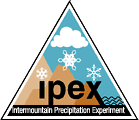

4.2 Forecast Products and Dissemination
A variety of forecast products, described in the table below, will be prepared by the forecast team for daily meetings and forecast verification. These products have been selected based on program needs and the desire to limit as much as possible the ambiguous validation of forecasts. Forecast products will be archived via a world wide web page and available over the internet. The forecast team will present their forecasts at the 11 MST briefing that will be attended by the Operations Coordination Team and other interested scientists.
OROGRAPHIC PRECIPITATION OUTLOOK: Categorical (yes/no) forecasts of orographic precipitation type which are needed for project planning. Precipitation type will be verified by subjective interpretation of radar imagery. It is possible for both stable and convective to validate in the same period. Categorical forecast for meeting criteria for Snow Advisory and Heavy Snow Warning criteria above 7000' in the Wasatch Mountains from Provo Canyon to Sardine Canyon.
LAKE-EFFECT PRECIPITATION OUTLOOK: Categorical forecasts of: if lake-effect precipitation will occur, a solitary wind-parallel band will develop, snow advisory or heavy snow criteria will be met, and if lake-effect precipitation will occur in Davis, Salt Lake, or Tooele Counties. This information is needed for forecast planning and to examine the predictability of lake-effect precipitation.
CG LIGHTNING OUTLOOK: Categorical and probabilistic forecasts of lightning in the target area. Decisions regarding the deployment rawinsondes with field mills requires this information. Product will be verified against observations from the Lightning Detection Network.
PROBABILISTIC QPF GRAPHIC: Graphical plots illustrating the probability of precipitation (liquid water eqivalent) exceeding .01", .1", .25", and .5" in the study area. Contours should be drawn at three levels: 25, 50, and 75%.
POINT QPF: Precipitation forecasts (liquid water eqivalent) for several points in the target area. Forecasters should be aware of the difficulties of measuring snowfall and liquid water equivalent in complex terrain either manually or with automated gauges such as the ETI gauge. Validation data will be a mixture of manual and automated observations as specified in the forecast products table.
ENVIRONMENTAL CONDITIONS: Forecasts for products needed for field-program planning or evaluation of operational utility made at 3-h intervals (i.e., 1800, 2100, 0000, 0300, etc...).
CONTINGENCY OPTION DISCUSSION: Technical discussion of the potential for P-3 reconnaisance near the Teton Mountains of Wyoming and Idaho or the Tushar Mountains of central Utah. This should be completed during periods where flights in the Wasatch Mountains are unlikely.
ADVANCED OUTLOOK: Brief technical discussion of the 2-4 day forecast that considers the potential for IOPs.
Guidance for forecasting lake-effect snowstorms can be derived from the recent paper by Steenburgh et al. (1999). Additional information concerning lake-effect of the Great Salt Lake is provided in Carpenter (1993) and Onton (1999). According to Steenburgh et al. (1999), lake-effect precipitaiton is most common overnight and in the early morning hours. Therefore, lake-effect IOPs will likely occur overnight, with operations ceasing in the early afternoon.
Forecasting orographic precipitation is covered by Dunn (1983).
Guidance for forecasting postfrontal lightning associated with lake-effect or orographic precipitation can be found in Schultz (1999). Schultz (1999) found that lake-effect snowstorms are more likely to produce lightning when the surface temperature is greater than 2°C. Similar values of 700-hPa temperature, surface-to-700-hPa temperature difference, and lifted index are -10.5°C, 13.7°C, and 1°C, respectively. Dewpoint depression and convective available potential energy are not useful in forecasting postfrontal lightning. 4.4 Nowcaster Responsibilities
NOWCAST DISSEMINATION: During field operations, the Operations Director will be responsible for coordinating nowcast input, position the mobile laboratories and DOWs, schedule balloon-borne EFM launches, and coordinate aircraft flight patterns with the P-3 chief scientist.
NOWCAST COMMENTS: The primary function of the nowcast team is to monitor data and relay information about precipitation location, movement, and significant changes in precipitation patterns. This function will require real-time access to many of the NWS operational data feeds. In general, the required products for nowcasting support include: northern UT radar composite, KMTX WSR-88D reflectivity and winds, one-km resolution infrared and visible satellite imagery, NLDN lightning data, profiler winds, Utah mesonet data, ADAS products, and Eta/RUC-2 forecast products.